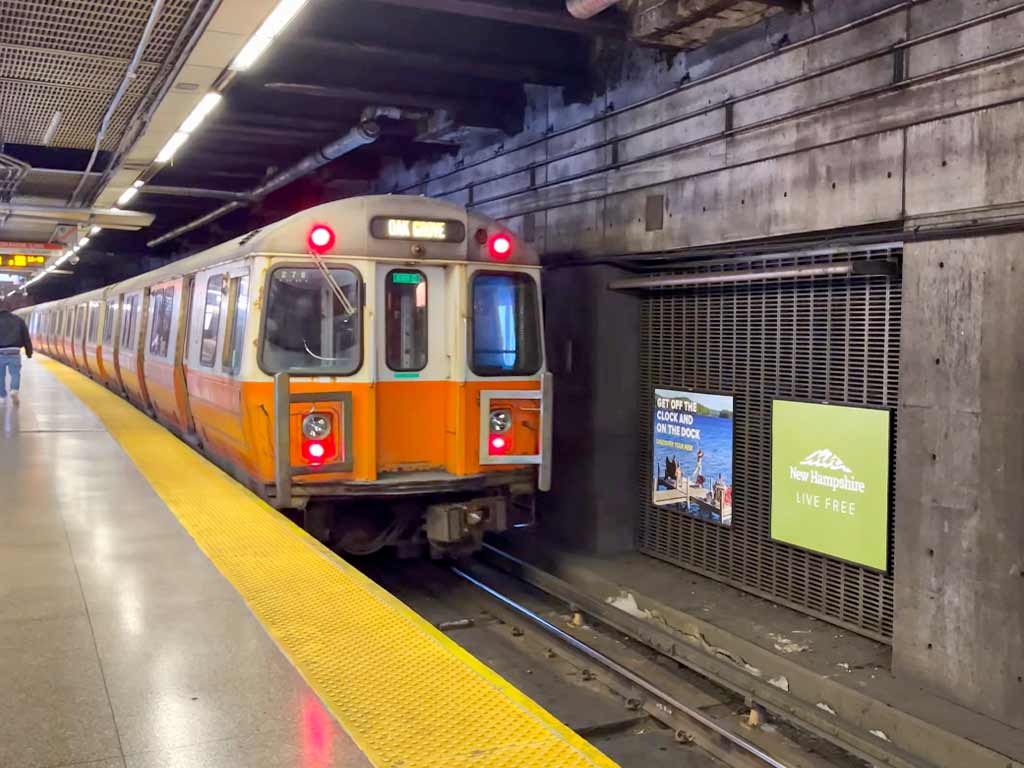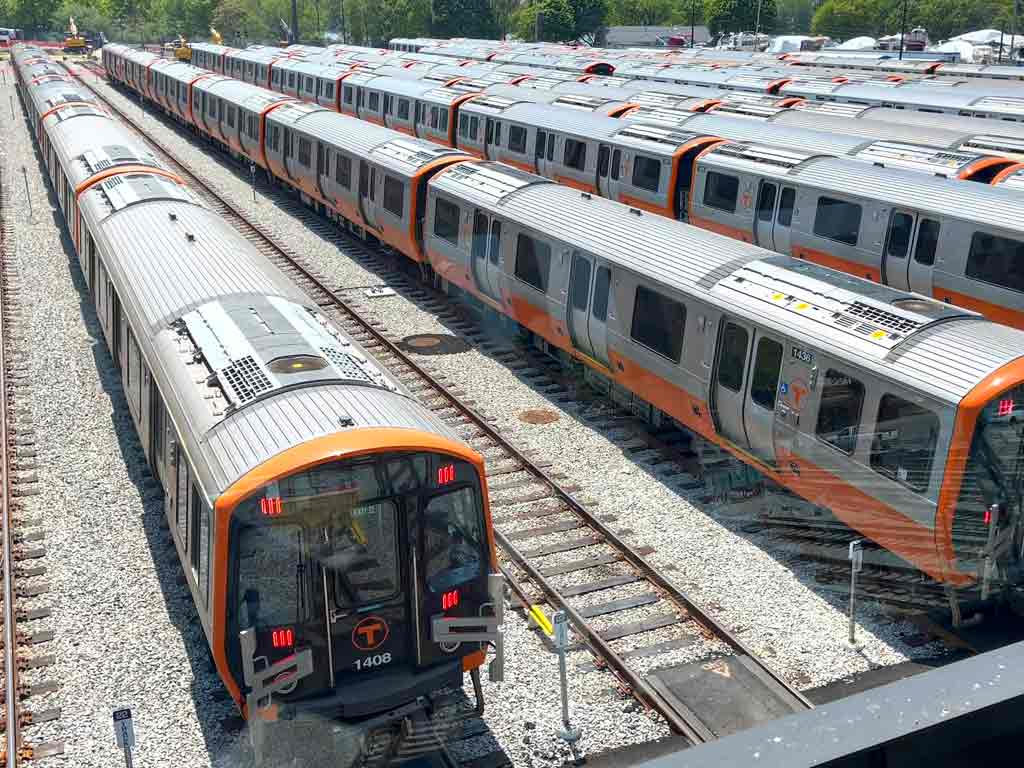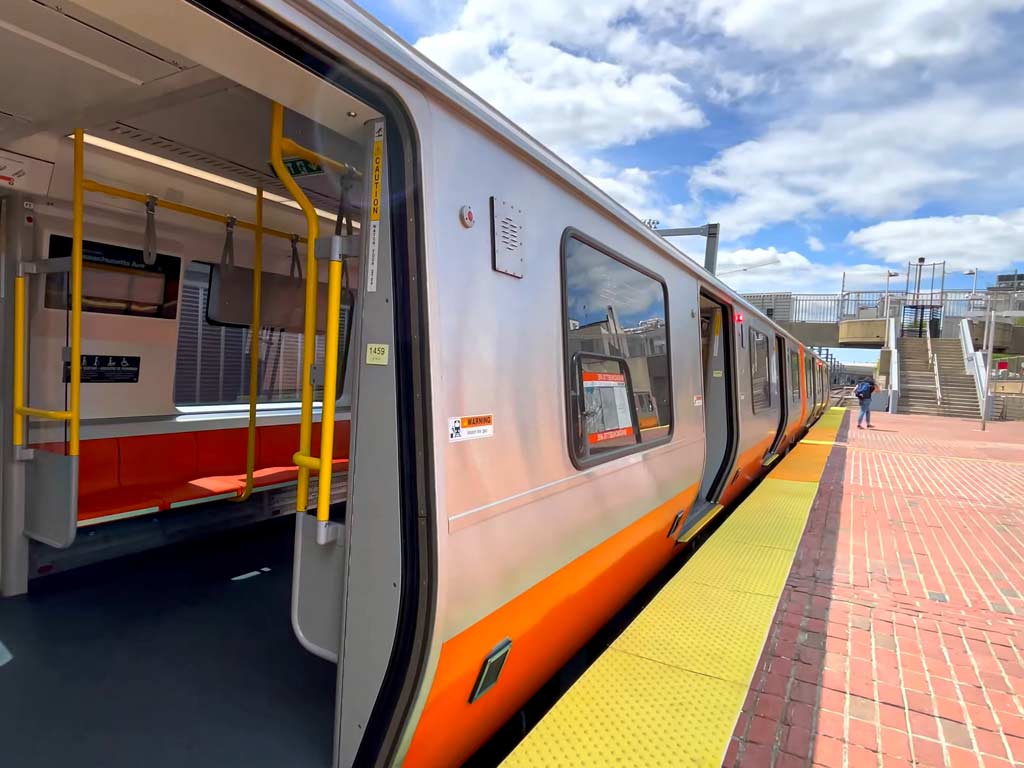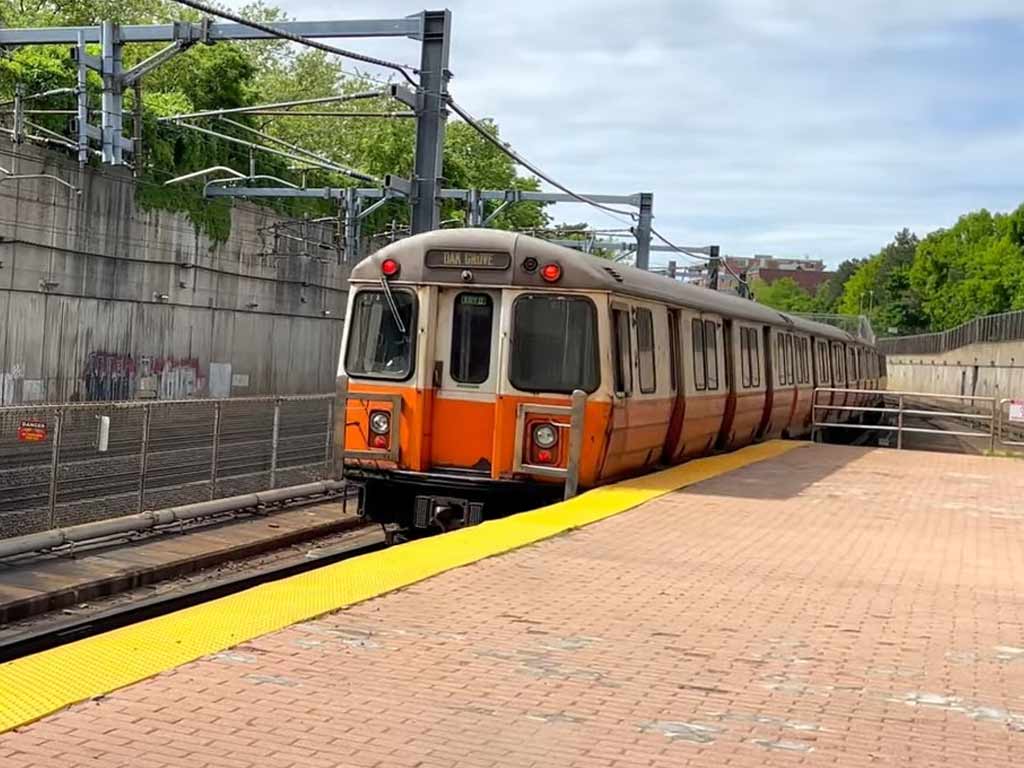In the vibrant tapestry of Boston, history meets modernity and the city pulses with energy. Amid this dynamic landscape, the “Boston Orange Line” emerges as a lifeline, connecting neighborhoods and weaving stories of urban life.
As one of the city’s key transit arteries, the Orange Line transcends its role as a mere transportation system; it’s a journey through Boston’s diverse communities, each stop echoing with its unique character.
From the bustling Downtown Crossing to the cultural enclave of Jamaica Plain, the Orange Line takes passengers on a captivating ride through the heart of the city.
In this exploration, we delve into the significance of each station, unveiling the hidden gems, historical landmarks, and local flavors that make the Orange Line a microcosm of Boston’s rich identity.
Join us as we embark on a visual and narrative expedition along the tracks of this iconic line.
All About the Boston Orange Line
Among the places of Boston, the Boston Orange Line stands out as a vital artery, connecting diverse neighborhoods and encapsulating the essence of this dynamic metropolis.
This narrative journey delves into the history, significance, and unique character of the Boston Orange Line, exploring its stations, landmarks, and the stories that unfold along its tracks.
Origins and Evolution
The Orange Line traces its roots back to the late 19th century when it was originally part of the Boston Elevated Railway. Over the decades, it transformed, transitioning from a traditional railway to the rapid transit system we recognize today.
The line acquired its distinct orange hue in 1967, a visual marker that distinguishes it amidst Boston’s bustling transit network.
Riding Through History

Embarking on a journey along the Orange Line is akin to traversing a timeline of Boston’s history. Starting at Oak Grove, the line meanders through stations with names resonating with historical significance Malden, Wellington, and Sullivan Square.
Each stop tells a tale, some echoing the industrial past of the city, while others bear witness to urban renewal and revitalization.
Downtown Crossing: A Hub of Activity
Downtown Crossing, a central point on the Orange Line, encapsulates the city’s commercial vitality. As commuters disembark, they are greeted by historic buildings, boutique shops, and the bustling energy of Boston’s financial district.
This station serves as a gateway to both the past, with its historic sites, and the present, with the vibrant pulse of city life.
Chinatown: A Cultural Mosaic
Continuing southward, the Orange Line arrives at Chinatown, a station that embodies Boston’s cultural diversity. Here, the air is infused with the aroma of diverse cuisines, and the streets resonate with languages from around the world.
Chinatown reflects the harmonious coexistence of tradition and modernity, making it a microcosm of Boston’s multicultural identity.
Back Bay: Architectural Grandeur
Back Bay station emerges as a testament to Boston’s architectural grandeur. Surrounded by Victorian brownstones and modern skyscrapers, it seamlessly blends the old with the new.
The Copley Square nearby offers a retreat into green spaces and cultural institutions, providing passengers with a glimpse of Boston’s commitment to preserving its heritage amid urban development.
Fenway: Sports and Culture Collide
Fenway, synonymous with Boston’s passion for sports, brings passengers closer to iconic landmarks like Fenway Park. The station vibrates with the cheers of Red Sox fans and exudes a unique blend of sports culture and artistic expression.
The murals and public art installations pay homage to the city’s love for both athletics and creativity.
Jamaica Plain: A Bohemian Haven
Jamaica Plain, the terminus of the Orange Line, unveils a bohemian side of Boston. This neighborhood embraces a laid-back atmosphere, dotted with local shops, art galleries, and community gardens.
The Sam Adams Brewery nearby adds a touch of craft beer culture, creating a perfect blend of leisure and local flair.
Challenges and Innovations

Despite its cultural significance, the Boston Orange Line has not been without challenges. Over the years, the line has undergone numerous upgrades and faced disruptions, including derailments and delays.
However, continuous efforts in modernization and safety measures have been implemented to ensure a reliable and efficient transit experience for Bostonians.
Community Impact
Beyond its role as a mode of transportation, the Orange Line has a profound impact on the communities it serves. Stations like Forest Hills and Roxbury Crossing serve as community hubs, fostering local businesses and contributing to the neighborhood’s socio-economic landscape.
The connectivity provided by the Orange Line is not just about moving people; it’s about linking communities and enhancing accessibility.
The Future of the Orange Line
Looking ahead, the Boston Orange Line remains a vital component of the city’s transportation infrastructure. Ongoing initiatives focus on improving the line’s reliability, expanding capacity, and incorporating sustainable practices.
As Boston evolves, the Orange Line adapts, ensuring its continued relevance in connecting the city’s past, present, and future.
What Is It Like to Ride on the Boston Orange Line?

Boston’s Orange Line, with its distinctive orange hue, is more than a mode of transportation; it’s a dynamic journey through the heart of a city rich in history and diversity.
This exploration delves into the commuter experience, capturing the essence of what it’s like to ride the Boston Orange Line.
The Commute Begins: Oak Grove to Downtown Crossing
As passengers board the Orange Line at its northern terminus, Oak Grove, they find themselves enveloped in the hum of anticipation. The train, adorned with an unmistakable orange color, sets the tone for the journey ahead.
Commuters settle into the familiar rhythm of their daily routine, their surroundings transitioning from the quiet residential areas of Oak Grove to the urban landscape as they approach the first major hub: Downtown Crossing.
Downtown Crossing serves as a bustling gateway to Boston’s commercial core. As doors open, a rush of people enters and exits, creating a symphony of activity. The platform’s energy is palpable, mirroring the heartbeat of the city itself.
The commute becomes a visual and auditory tapestry, weaving together the diversity of Boston’s workforce and the vibrant pulse of urban life.
Neighborhoods Unfold: Chinatown to Back Bay
Heading southward, the Orange Line navigates through neighborhoods that each possesses a distinct character. Chinatown, a cultural crossroads, greets passengers with a sensory experience.
The aroma of diverse cuisines wafts through the air, and the station’s ambiance mirrors the multicultural tapestry that defines this part of Boston.
As the train continues, it arrives at Back Bay station, an architectural gem nestled among historic brownstones and modern skyscrapers.
Commuters witness the juxtaposition of old and new, a testament to Boston’s commitment to preserving its heritage amid the ever-evolving urban landscape.
Back Bay offers a brief respite, inviting passengers to explore nearby Copley Square’s green spaces or cultural institutions.
Leisurely Vibes: Jamaica Plain and the End of the Line

Approaching the southern terminus, Jamaica Plain introduces a more laid-back atmosphere. Commuters exit the train into a neighborhood that embraces a bohemian spirit.
Local shops, art galleries, and community gardens paint a picture of leisure and local flair. The nearby Sam Adams Brewery adds a touch of craft beer culture, providing a unique flavor to the Orange Line experience.
Sports Enthusiasm: Fenway and the Cheers of Fans
Fenway, synonymous with Boston’s sports fervor, elicits a unique atmosphere. Passengers can feel the excitement building as they approach the station.
The cheers from Fenway Park echo through the walls, creating a harmonious blend of sports culture and urban transit.
Murals and public art installations celebrate the city’s love for both athletics and artistic expression, making Fenway a distinctive stop on the Orange Line journey.
Challenges and Interruptions: Navigating Disruptions
While the Orange Line offers a well-established and reliable transit experience, it’s not immune to challenges. Commuters may encounter delays, occasional disruptions, or crowded conditions during peak hours.
The transit authority’s continuous efforts to address these challenges include infrastructure upgrades, maintenance initiatives, and communication strategies to keep passengers informed.
Communal Hubs: Forest Hills and Roxbury Crossing
Beyond being a means of getting from point A to B, the Orange Line serves as a vital connector for local communities.
Stations like Forest Hills and Roxbury Crossing function as communal hubs, fostering local businesses and contributing to the neighborhood’s socio-economic landscape.
These stations are not just transit points; they are integral components of the communities they serve.
The Future of Commuting: Ongoing Developments
Looking ahead, the future of riding the Boston Orange Line promises enhancements and innovations. Ongoing initiatives focus on improving reliability, expanding capacity, and incorporating sustainable practices.
Modernization projects aim to elevate the commuter experience, ensuring that the Orange Line remains a relevant and efficient transit option for Bostonians.
A Commuter’s Reflection
For the daily commuter, riding the Boston Orange Line is more than a routine; it’s an intimate engagement with the city’s pulse.
From the diverse landscapes of Chinatown to the sports-filled aura of Fenway, each station paints a different stroke in the canvas of Boston’s urban portrait.
The challenges and interruptions are part of the journey, reminders of the shared experience that binds commuters together.
FAQs
How long is the Boston Orange Line?
The Boston Orange Line spans approximately 13.5 miles, connecting Oak Grove in the north to Forest Hills in the south.
How often do trains run on the Orange Line?
Trains on the Boston Orange Line typically run at intervals of 6 to 12 minutes during peak hours and 10 to 15 minutes during off-peak times. Schedules may vary on weekends and holidays.
What are some notable attractions along the Orange Line route?
The Orange Line passes through diverse neighborhoods, with attractions such as Downtown Crossing for shopping, Chinatown for cultural experiences, Back Bay for architectural beauty, Fenway for sports enthusiasts, and Jamaica Plain for its bohemian charm.
Are there any planned upgrades or expansions for the Boston Orange Line?
Yes, ongoing initiatives focus on modernizing the Orange Line, including infrastructure upgrades, capacity expansions, and efforts to improve reliability. These developments aim to enhance the overall commuter experience.
How does the Boston Orange Line contribute to community development?
Stations like Forest Hills and Roxbury Crossing serve as community hubs, fostering local businesses and contributing to the socio-economic landscape of the neighborhoods they serve.
The Orange Line plays a crucial role in connecting communities and promoting accessibility.
Conclusion
The Boston Orange Line transcends its utilitarian function, evolving into a cultural conduit that mirrors the essence of the city it serves.
As we reach the end of our journey, we’ve witnessed the amalgamation of past and present, witnessed the diversity thriving in each station, and felt the heartbeat of Boston pulsating through the tracks.
From the historic landmarks at Haymarket to the artistic vibes of Forest Hills, the Orange Line encapsulates the spirit of Boston’s neighborhoods.
So, next time you find yourself on the Orange Line, take a moment to absorb the surroundings, strike up a conversation with a fellow traveler, and savor the unique character of each stop.
The Boston Orange Line is more than a means of getting from point A to B; it’s a vibrant chapter in the ongoing story of Boston, inviting you to be a part of its narrative.
Jaclyn Lowe